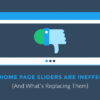
What Is a Design Brief?
Writing a design brief is complicated, but it doesn’t have to be! The great news is, with a little help, anyone can write an excellent design brief. Our beginner’s guide on how to write a design brief will take you through the process.
A design brief is like a business plan. It outlines the objectives, aims, and milestones of a project for designers to follow. Briefs enable clients to communicate their vision to designers and make that vision a reality.
When a project begins, many questions need to be answered. All businesses have a concept of how they want to market their product or service to consumers, so they create a design brief. Professionals create logos, websites and other advertising from the points in a brief, so they’re essential for transparent communication between businesses and design agencies.
Case Study
Caroline has owned an e-commerce store for two years now but has recently noticed that her website isn’t performing well. After looking at her competitors, she knows that rebuilding the site is essential, so she uses a design agency.
After contacting many agencies with her request, Caroline receives several responses asking him for the design brief. She cannot provide a brief, so the design company doesn’t know what Caroline wants. This makes the whole process harder, and Caroline isn’t happy with the result.
If Caroline had provided a brief, the design agency could have made her vision a reality. The problem was, she thought a design brief was a complex document, with lots of information.
However, a design brief is a basic document outlining your requirements for a logo or website. You can think of it as a job description, describing what your business is about and how you want to portray it with the design.

Why Use a Design Brief?
Think about things from a designers perspective. They receive an email from a company asking for a logo. The only information they provide is what their company offers customers, and that’s it. How does a designer create a logo based on limited information?
A design brief helps agencies understand what you want to achieve. Having a professional website built, costs money and many businesses are unhappy with the finished site. Professional designers aren’t mind-readers, and without a design brief, they won’t be able to meet your requirements.
Putting together a robust brief means you won’t have to communicate with the company so often. When professionals have an idea about what your requirements are, they can focus on bringing your ideas to life.
How to Write a Design Brief
Your design brief should be simple to understand, and straight to the point. You’re not writing a novel, and agencies appreciate knowing what they’re expected to deliver. Depending on the size of your business, you could have a marketing professional create your design brief. If this is the case, you should still communicate with your team and consider design element that will appeal to your customers.

If you’re writing a website brief, this is what you need to include.
Who are you? Determine your business identity
Check out company websites, and you’ll see many of them have a similar theme depending on the industry. This is because specific designs work for businesses and convey the right image to customers. For example, eco-friendly companies use green and brown colours for their website, because they symbolise nature. Letting designers know what your company does is vital for your design brief.
You should also list the products you sell and provide details about your conversions. Does your company have a USP? Tell the agency about it so they can highlight what makes you unique in their design.
What are you hoping to achieve?
OK, you’re investing a lot of money in re-branding your company and it isn’t for nothing. Are you expanding your company or introducing a new product range? Do you want to attract more visitors to your website? Make your goals clear to designers.
A great example of setting a goal is giving designers a simple but clear brief of what you want to achieve:
“We’re a small, family-run business selling party-related products. We’re failing to stand out in an already crowded market and it’s becoming increasingly difficult to sustain a consistent flow of business.
We want to leave more of an impression on our visitors and become the “go to” provider of party products. Ideally we would like a bold, inviting website which which attract customers and be memorable.”
Whether you only have one goal, or a set of goals you’d like to achieve, writing them down will help design agencies. We advise you to let the agency know which goals are most important to you.

Who is your target audience?
Great designs highlight the positive aspects of a company, but customers make it successful. If you make no sales, then you won’t need a website! However, so many companies focus on their wants instead of customers needs.
Your website should be a solution for your customers’ problems, so it’s essential you understand what they are. One of the best ways to identify your target audience is using a technique called Buyer Persona Strategy.
Try to include at least three personas and don’t be afraid to go into a lot of detail. An experienced agency will have worked with buyer personas before and will appreciate the extra information you provide.

The design specifications
Once you make it through this incredibly dull part of your website design brief, you can breathe a sigh of relief and concentrate on the more exciting aspects. You need to tell agencies:
- How your current site was built.
- If you would like to change to another hosting platform.
- Which analytics tools you use.
- If any pages need extra attention.
Your agency might recommend changes to your website, or advise you to use another hosting service. Be open to their suggestions and remember they know what they’re doing!
Performance Indicators
Using a professional design agency is an investment, so you should be clear on what you expect from them. Failure to do this means if they don’t meet your requirements, they might try to charge you more money to make changes.
Here are some examples of performance indicators:
- We have a set budget for the website design and development
- We want to increase exposure on search engines
- Our website security is important
- We would like you to create professional website content.
- Our timescales for website launch are within 3 months
- Our goal is to increase the time visitors spend on site
Giving an agency this information means they’ll approach the project with clear goals in mind, which will get you the desired results. Remember, agencies are working for you and should welcome performance indicators.

Your Budget
You want a mind-blowing website, but can you afford it? Setting a firm budget is something every company must do. Never tell a design agency you’re willing to pay anything because you’ll end up with a hefty bill. Find out how much a website costs before contacting an agency. Agencies are businesses too, so be clear on what you’re willing to spend.
Many clients can often be resistant to revealing a website budget as they feel this will then leave them in a weak position to negotiate. In reality, a budget is a critical element for an agency to determine to what degree they can help you and the level of involvement which can be put into each stage of the project. An established agency will have website designers with varying levels of experience and skill and your budget will determine who is suitable for the project.
Consider walking into a car dealership – they are hundreds of different models of car and a salesperson will be of no help if he doesn’t know whether you’re looking for a Ford or a Ferrari. The same applies to website design.

Deadlines and Timescales
Isn’t it lovely when someone tells you there’s no rush to complete something? It means you can put a job to the back of your mind and focus on more pressing issues. Make sure you tell the agency when you want the work to be completed. This way you’ll be able to complain if they don’t deliver on time. Likewise, website designers typically work to a strict schedule and without a timeframe, they’ll be unable to manage your project properly.
Sometimes an agency will tell you they can’t deliver at short notice, but there are plenty of agencies available. Think about how much you want to work with the agency and if you’re willing to wait. One thing to consider is if an agency can deliver immediately, then they don’t have many clients. Is there a reason for this?
Who’s in Charge?
If you’re working in a team, it’s vital that one person takes the role of lead contact. Your design agency will need to reach out with updates and questions, so it’s crucial you’re available and able to sign off on work completed.
Most agencies have account managers to manage client relationships, and as a business owner, you should delegate your own project manager. More experienced agencies with firm processes in place to ensure projects run smoothly will often only be willing to work with the primary decision maker for the project. This helps eliminate miss-delivery and project scope creep which can be crippling for a business.

Ready to write your design brief?
So now you know about design briefs, it’s time to write yours. Think about what you’re looking for and remember these key points:
- What is your business and what do you sell?
- Who are you selling to?
- What are your goals and performance indicators?
- How much are you willing to spend?
- When should the design be completed?
- Our goal is to increase the time visitors spend on site
Writing a web design brief can be a daunting process if you’ve never created one before. If you’re looking for a website and are struggling with any elements on writing a brief for your agency, please feel free to get in touch for assistance.









